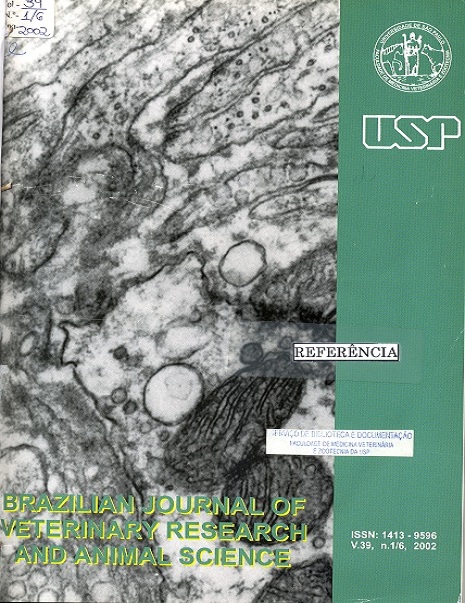Determination of nematode faecal egg counts during the periparturient period in cows
DOI:
https://doi.org/10.1590/S1413-95962002000100006Keywords:
Cows, Nematodes, Parasite egg countAbstract
Two experiments were carried out to study the changes in the nematode faecal egg counts (EPG) in cows, during the periparturient period. In the first experiment, faeces from Holstein (dairy) and Zebu (beef) cows, were examined from the 6th week before birth up to the 6th week after birth. It was observed a significant difference (p<0,05) with a higher number of cows, from the Holstein group, with nematode eggs in faeces. In the dairy animals a significant rise in the EPG was observed at the moment of birth and on week four post parturition, when compared to pre parturition period. A negative association was found between the time of parturition and EPG, with the younger cows presenting higher EPG (p<0.05). Based on these results a second experiment was conducted to compare the EPG variations from the 4th week before birth up to the 10th week post parturition, in Holsteins cows, including primary and second gestation (group 1), and 3rd or more gestation (group 2). It was observed a significant difference with cows from the 1st and 2nd gestation showing higher EPG than group 2, at week 2, 3 and 4 after birth (p<0,05). The EPG from group 1 ranged from 0 to 1800, and from group 2 from 0 to 150 EPG. The results suggest that an anthelminthic treatment around the 2nd week before birth, in cows at the 1st and 2nd gestation, will decrease pasture contamination and nematode infection.Downloads
Download data is not yet available.
Downloads
Published
2002-01-01
Issue
Section
UNDEFINIED
License
The journal content is authorized under the Creative Commons BY-NC-SA license (summary of the license: https://
How to Cite
1.
Gennari SM, Blasques LS, Rodrigues AAR, Cilento M do C, Souza SLP de, Ferreira F. Determination of nematode faecal egg counts during the periparturient period in cows. Braz. J. Vet. Res. Anim. Sci. [Internet]. 2002 Jan. 1 [cited 2024 Apr. 19];39(1):32-7. Available from: https://www.revistas.usp.br/bjvras/article/view/5936





